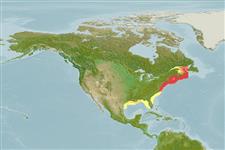Classification / Names
Common names from other countries
Main reference
Size / Weight / Age
Max length : 76.0 cm TL male/unsexed; (Ref. 6885); 61.7 cm SL (female); common length : 50.0 cm SL male/unsexed; (Ref. 188); max. published weight: 5.5 kg (Ref. 7251); max. reported age: 13 years (Ref. 72462)
Length at first maturity
Lm ?, range 38 - 48.5 cm
Environment
Marine; freshwater; brackish; pelagic-neritic; anadromous (Ref. 51243); depth range 0 - 250 m (Ref. 6793)
Climate / Range
Temperate, preferred 10°C (Ref. 107945); 61°N - 22°N, 115°E - 59°W (Ref. 188)
Distribution
North America: Newfoundland (Ref. 1998), the St. Lawrence River, and Nova Scotia southward to central Florida. Due to introductions into the Sacramento and Columbia Rivers, this species is now found from Cook Inlet, Alaska (Ref. 1998) to Baja California in Mexico and the Kamchatka Peninsula.
Countries | FAO areas | Ecosystems | Occurrences | Introductions
Short description
Dorsal
spines
(total): 0;
Dorsal
soft rays
(total): 15-19;
Anal
spines: 0;
Anal
soft rays: 18 - 24;
Vertebrae: 51 - 60. Moderately compressed, belly with a distinct keel. Lower jaw not rising steeply within mouth. Gill rakers long and slender (fewer in young). Silvery in color with blue or blue-green metallic luster on back (Ref. 1998). A dark spot on shoulder, sometimes followed by several more, or even a second row. Resembles A. pseudoharengus with lower jaw rising steeply within mouth, eyes larger, and fewer lower gill rakers, as also A. aestivalis and A. mediocris (Ref. 188). Silvery, with a green or bluish back (Ref. 7251). Branchiostegal rays 7 (Ref. 4639).
IUCN Red List Status (Ref. 115185)
Threat to humans
Harmless
Human uses
Fisheries: commercial; gamefish: yes
Tools
Special reports
Download XML
Internet sources
Estimates of some properties based on models
Phylogenetic diversity index
PD50 = 0.5000 many relatives (e.g. carps) 0.5 - 2.0 few relatives (e.g. lungfishes)
Trophic Level
3.5 ±0.3 se; Based on diet studies.
Resilience
Low, minimum population doubling time 4.5 - 14 years (K=0.14; tm=4.7)
Vulnerability
Moderate to high vulnerability (51 of 100)
Price category
